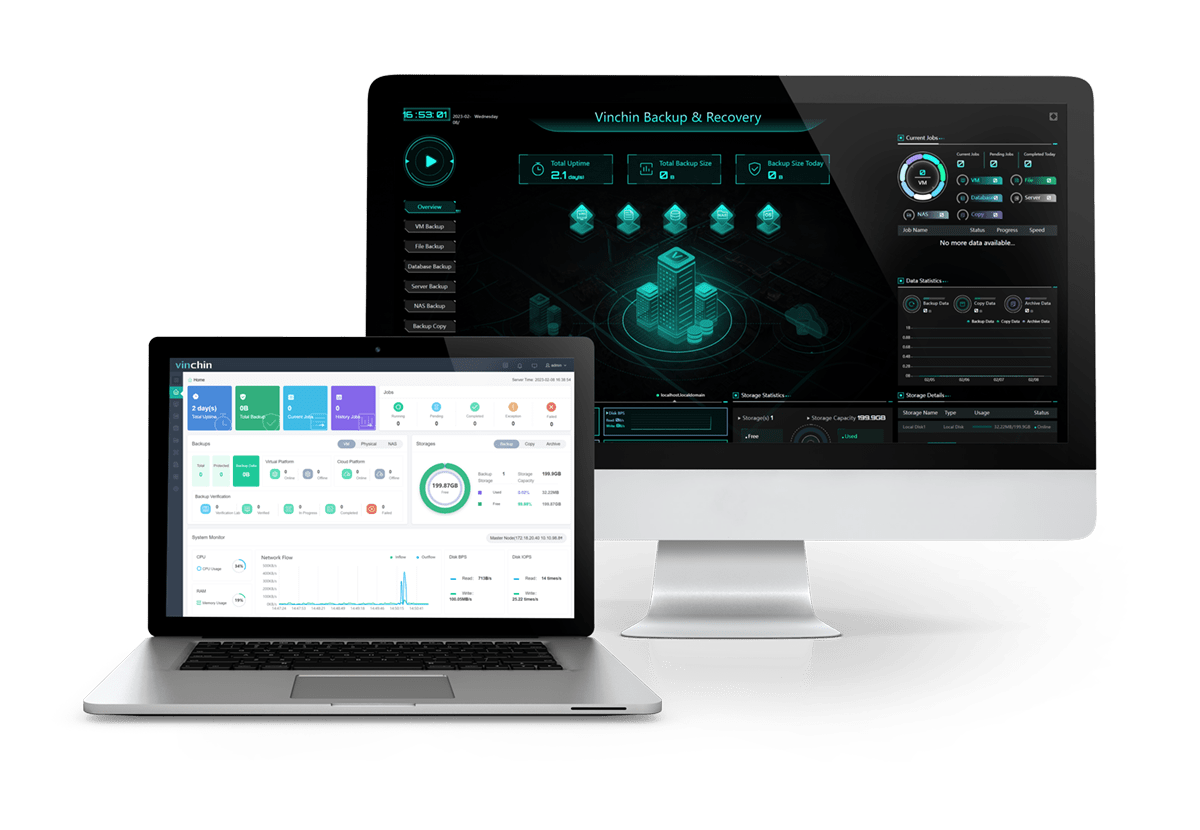-
Disaster recovery requirements
-
Backup strategies
-
Backup cycle
-
Backup storage
-
Data recovery
-
Disaster recovery level
-
Implementation cost
-
Guaranteeing the safety of virtual machines
-
Conclusion
With the increasing amount of data in an organization, the need for a disaster recovery system whoes main goal is to ensure that an enterprise can quickly and completely recover its data and systems in the event of various disasters or accidents to minimize business interruption and data loss is becoming increasingly prominent.
Disaster recovery requirements
In order to meet this demand, it is necessary to conduct an in-depth research and analysis of the business continuity needs of the enterprise, the amount of tolerable data loss, disaster recovery time objectives (RTO), data security requirements, and other aspects.
Backup strategies
The backup strategy is an integral component of the disaster recovery plan. Based on the specific needs of the organization, it is recommended to implement the following backup strategy:
1. Full Backup: Perform a full backup on a weekly or monthly basis, encompassing all data. This backup method is simpler, but requires more storage space and backup time.
2. Incremental backup: Backup only the files or data that have changed since the last backup, on a daily basis. This backup method can greatly reduce storage space and backup time, but requires a more complex backup process to ensure data integrity.
3. Differential Backup: A full backup is performed once a week or once a month and records files or data that have changed since the last full backup. This type of backup is between full backup and incremental backup, and can take care of both storage space and backup time requirements.
Backup cycle
Based on the importance of data and business requirements, the following backup cycles are recommended:
1. Critical business data: It is recommended to back up at least once a day and retain the last 7 days of backup data.
2. Non-critical business data: It is recommended to back up at least once a week and keep the last one month's backup data.
3. Infrequently modified data: It is recommended to back up at least once a month and retain the last one year of backup data.
Backup storage
Backup storage is one of the key parts of the disaster recovery plan and you need to make sure that the storage device has the following characteristics:
1. High Reliability: Storage devices need to have high reliability to ensure the integrity of backup data. It is recommended to choose brands and models with good reputation and market recognition.
2. Large capacity: As the amount of data continues to increase, storage devices need to have large capacity and high scalability to meet the needs of future data growth.
3. Storage Management: The storage device should have an easy-to-use management interface for administrators to configure, manage and maintain.
Data recovery
Data recovery is an important procedure in disaster recovery, and you need to ensure that the recovery process is fast, accurate and reliable. For different backup strategies and data types, corresponding recovery strategies should be adopted:
1. Full Backup Recovery: Full backup recovery is the simplest, you can directly restore the backup file to the production environment. However, you need to be aware that the recovery time may be longer.
2. Incremental Backup Recovery: Incremental backup recovery requires first recovering all incremental backups since the last full backup and then recovering the latest incremental backup. The recovery time is relatively short because only the changed files or data are restored.
3. Differential backup recovery: Differential backup recovery requires first recovering all differential backups since the last full backup and then recovering the latest differential backup. The recovery time is relatively short as only the changed files or data need to be recovered.
Disaster recovery level
Disaster recovery level refers to the system's ability to withstand disasters. Based on the specific needs of the enterprise, we recommend adopting the following disaster recovery levels:
1. Local Disaster Recovery: Establish a disaster recovery center locally, where critical business data and systems are backed up and recovered. This disaster recovery method is relatively simple and cost-effective but can only withstand smaller-scale disasters.
2. Remote Disaster Recovery: Establish a disaster recovery center at a remote location, where critical business data and systems are backed up and recovered. This disaster recovery method can withstand larger-scale disasters but requires higher costs and technical support.
3. Multi-level Disaster Recovery: Simultaneously establish disaster recovery centers at both local and remote locations, where critical business data and systems are backed up and recovered. This disaster recovery method offers the highest level of protection against disasters of all scales but requires the highest costs and technical support.
4. Multi-level Disaster Recovery: Simultaneously establish disaster recovery centers at both local and remote locations, where critical business data and systems are backed up and recovered. This disaster recovery method offers the highest level of protection against disasters of all scales but requires the highest costs and technical support.
Implementation cost
When formulating the implementation plan of the disaster recovery system, you need to fully consider the principle of cost-effectiveness to ensure that the implementation of the system will not bring excessive economic pressure on the Organization The following are the main implementation costs:
1. Hardware costs: Includes the cost of purchasing infrastructure such as servers, storage devices, network equipment, etc.
2. Software costs: Includes the cost of purchasing software such as operating systems, databases, backup software, etc.
3. Labor costs: Includes labor costs for system administrators, technical support staff, etc.
4. Power costs: Includes the cost of power consumption for servers, storage devices, and other equipment.
5. Site costs: Includes the cost of renting or building a site such as a data center.
6. Training costs: Includes the cost of training administrators and technicians.
7. Maintenance costs: Includes the cost of equipment maintenance and technical support.
Guaranteeing the safety of virtual machines
To summarize, when implementing a procedure plan in disaster recovery, we need to comprehensively consider the needs. Analyze the disaster recovery requirements, strategies, backup cycle, backup storage, data recovery, disaster recovery level etc. And based on the actual needs of the enterprise to choose the most appropriate program to achieve business continuity and data integrity.

Vinchin Backup & Recovery is a backup solution designed for virtual machines of VMware, Hyper-V, XenServer, XCP-ng, oVirt, RHV, etc. It provides comprehensive and powerful VM backup and recovery features like agentless backup, instant recovery, V2V migration designed to protect and manage critical data in the virtualization environment.
Vinchin Backup & Recovery’s operation is very simple, just a few simple steps.
1. Just select VMs on the host
2. Then select backup destination
3. Select strategies
4. Finally submit the job
Vinchin offers a free 60-day trial for users to experience the functionality in a real-world environment. For more information, please contact Vinchin directly or contact our local partners.
Conclusion
To ensure rapid recovery of data and systems, organizations must have a robust disaster recovery plan in place. In the process, careful consideration needs to be given to backup strategy, backup cycles, storage solutions, data recovery methods, disaster recovery levels, and associated implementation costs. In addition, organizations should thoroughly evaluate and select the right VM backup and recovery solution based on their specific needs and requirements. Such as Vinchin Backup & Recovery.
Share on:








